
Visit to Nepal, in 2009
To Frankfurt Airport.
In Frankfurt, I fail to locate the expected shuttle bus to the hotel. When I ring the hotel, it transpires that while there is a shuttle from hotel to airport, there is none in the opposite direction. They do, however, inform me that I could take bus 751. I swallow an oath while realising that this may explain why the hotel did not answer any of the questions I put to them via e-mail.
The above mentioned shuttle to the airport is a bit of a con too since it will cost me 20 euro extra, or the same as a normal taxi. However, they generously promise me a reduced tariff of 19 euros. I book the shuttle for 8 am the next morning but make it quite plain that I feel cheated. The room is quite o.k. although not the single room I booked since there is a double bed.
I decide to have an early night while wondering how things will turn out tomorrow.
Tuesday, 20-10-2009.
To Bahrein.
In Bahrein, I stay in the Gulf Gate Hotel from 19:30 till 04:00. I share a room with a German woman who is traveling with acquaintances, a married couple.
Wednesday, 21-10-2009.
To Kathmandu.
During the safety check at the airport they find, to my surprise, my Leatherman multi-tool inside my backpack with photographic equipment. In a moment of temporary insanity I must have put it in the wrong pack when getting ready at home. This probably happened because of the constant repacking to try to get the best weight distribution over the 2 pieces of luggage. Of course an extra 300gm in the main pack (that weighed 20.4kg) would have been quite alright. That’s the last I see of my multi-tool. How stupid.
We depart at 6 am and make one stop in Damman which means it’s not till 3 pm that we get to Kathmandu. A direct flight takes only 4 hours. Damman is a sandy desert. We don’t have to leave the plane. I spend all my time listening to and reading the Harry Potter book. This is the first one of the series I’ve read and I think it’s quite well written. It’s no surprise that the series has become such a success and not only amongst children. When I finish reading there is only 2 hours flighing time left which I occupy listening to my music.
Getting back to the Harry Potter book for a moment, and in particular the sound recordings, I’m at a failure to understand why the files do not appear in the exact same order as in which they were on my PC before I copied them to the player. In fact I copied whole folders to the player and made no use of the special music folder thinking that that would be more reliable.
I’m seated on the left-hand side of the plane and for a long time have a good view of the Himalayas. There is a strip of cumulus clouds in front of the high mountains but the peaks themselves are free of clouds. In Kathmandy it’s cloudy as well and the temperature is such that I don’t need to wear my fleece. It’s quite mild.
As usual the traffic is very heavy and after the first jam, Arjun takes a route which is totally unfamiliar to me. Kame goes along on my first shopping trip during which I buy a pair of comfortable trainers for Rs. 1450 and a thick self-inflating sleeping mat for Rs. 4000. I check into the Tibet Guest House and get room 601 which is situated near the roof terrace. A nice position but getting there, when the electricity is off, must be appreciated for the good exercise it is.
Kame promises to be back on deck next morning at about 9. The program for that day includes some more shopping, a visit to Multi Adventure to inspect the hotel and office and to organise the coming trek and finally a visit to Kame’s home.
When Kame has left, I put on my new trainers and go out to see whether I can find a Nepalese version of “Harry Potter and the philosopher’s stone”. The Walden Bookshop sells no books in the Nepalese language at all. In the shop next to the restaurant Third Eye they do but the Harry Potter book is not in stock. I place an order and am told I can collect it the next day.
On my way back to the Tibet Guest House, I make one further purchase, a nice small backpack costing Rs. 1400. It has rather a lot of zips, but my camera bag fits into it very well and it has enough straps on the sides to secure a tripod and a water bottle to it.
I decide not to do any e-mailing that day. Tomorrow is soon enough. I also will have to buy postcards and stamps then. I can do that in the bookshop when I go there to collect the book I ordered.
I have something to eat and drink a bottle of beer. Round 20:30 I go to my room for what I hope will be a long and restful sleep.
Thursday, 22-10-2009.
Kathmandu.
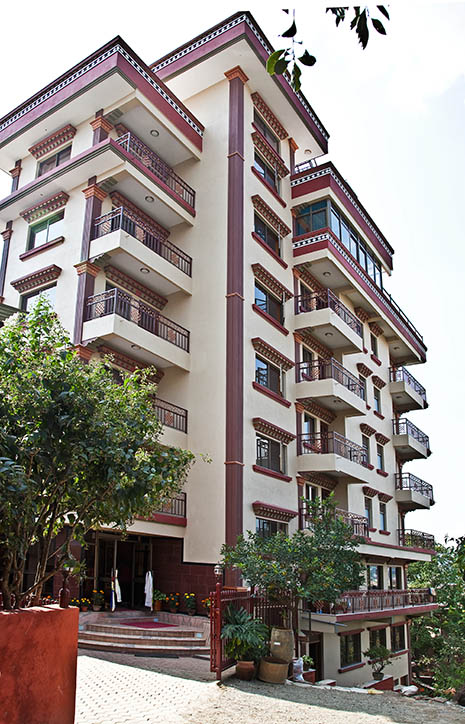
Kathmandu View Hotel.
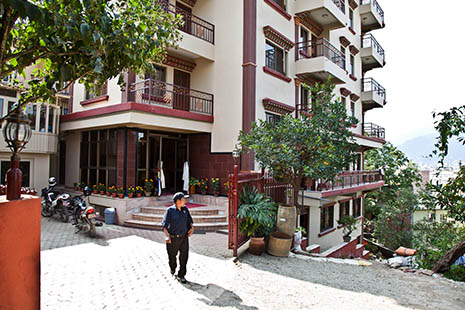
Kathmandu View Hotel.
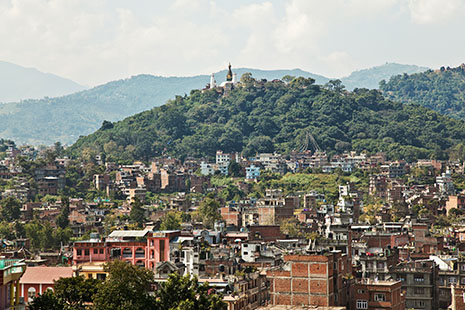
Swayambhunath, the monkey temple, as seen from the Kathmandu View Hotel.
I’ve an old-fashioned Nepalese bathroom so there is no bath, no shower recess or shower curtain. Thus the whole bathroom floor floods when having a shower.
I get the impression that breakfast has become cheaper. The breakfast buffet that includes fried sausages, tomatoes, fruit juice, omelette and coffee costs Rs. 240.
Kame arrives just before I finish my breakfast. We start off with the purchase of a wide-necked drinking bottle that fits in my insulated bag. Kame remembers just in time to ask for fleecy long johns. They will surely keep me warm in the evenings. Kame is no doubt right when he points out that there will be no need for down pants now that the Yalung La is no longer on our route.
The banks are open and we go to get some currency. I get an exchange rate of Rs. 109.82 per Euro. Yesterday, at the currency traders, I saw a rate of 107.32 and earlier today one of 108.32. Our going to the bank therefore gives an advantage of 1.5 rupees per euro which is not to be sneezed at when exchanging 1000 Euros.
Then on to the office of Multi Adventure. This is now based in a new building together with a hotel. The office was officially opened at the end of March (so Ngima was still with us at that time) and the hotel has been going for a month. The name Kathmandu View Hotel is quite appropriate as a look from the roof terrace confirms. I’m quite taken aback when we get to the hotel site. When I last saw it it was no more than a rough construction site. We drove to it via a road that I had not been on before. In fact it’s within 5 minutes walking from Thamel. The hotel is beautifully furnished and the office too looks beautiful and efficient. Ngima’s responsibilities with respect to contacts with clients have been taken over by Mingmar. Indra is mainly occupied with organising treks. Ngima’s wife is in charge of the supplies depot.
We finalise all aspects of our trek. Multi Adventure presents a bill with the following items: USD 180 service charge, USD 100 for insurance of their personnel on the trek, USD 15 for the permit, USD 120 for transport to Bahrabise and USD 274 for transport from Jiri to Kathmandu. This last item is a bit of a blow since I had estimated that it would be no more than USD 150. Perhaps it would have been cheaper to fly from Phaplu. I had planned to have them drop me off at Pharping on our way back but it appears that one has to go to Kathmandu first whichever way you go. In which case a night’s rest in Kathmandu makes sense.
I then learn that all resorts within the Chitwan National Park are closed. The leasing agreements with the Government have recently expired and no new ones have been signed yet. I decide to extend the planned stay at Green Mansions at least if Tulsi Magar is still employed there. I ask them to find out about this.
We decide to have lunch at Multi Adventure. The “girl” that serves us turns out to be a mother of two. Her husband died after becoming ill during a trek to the Annapurna BC. We subsequently discover that we are treated to the lunch as a welcome gesture.
After lunch we go into Thamel. Kame does some shopping for our trip while I ask about the Nepalese Harry Potter book and buy some post cards. We also buy, for Rs. 1500, a small backpack, that I want to give to Furi. Then we go via Durbar Square, the entry price has gone up from 200 to 300 rupees, to New Road where I buy a tripod in the Snapper Photo shop. It’s just like the one I have lying at home; it costs me 290 Euro.
After that we split up. Kame goes home and I go to my hotel, taking pictures along the way. I also collect the Nepalese Harry Potter book for which I pay the amazing sum of Rs. 215. I discover that so far 3 books in the series have been translated into the Nepalese language.
I also visit a chemist’s and buy a strip with fifteen 10 mg tablets of Nitrazepam. That should do me for quite a while. Today’s diary entries are made while eating several bananas and by the light of my LED light attached to my headband since the electricity has once again been turned off.

View over Kathmandu, from the roof terrace of the Kathmandu View Hotel.
Friday, 23-10-2009.
Kathmandu.
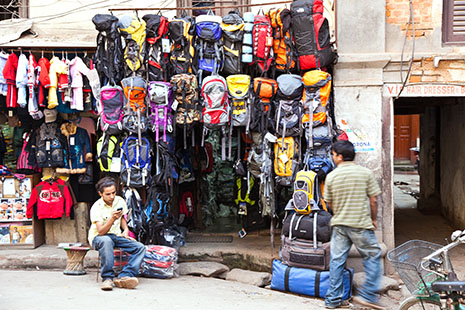
A shop in Thamel.
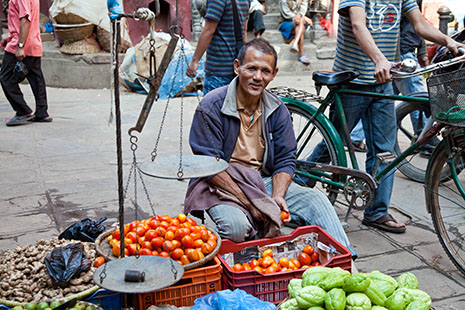
Selling groceries in Thamel.
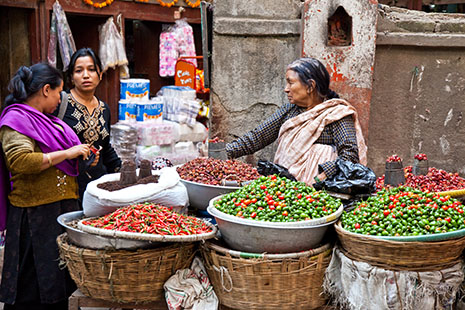
Selling peppers in Thamel.
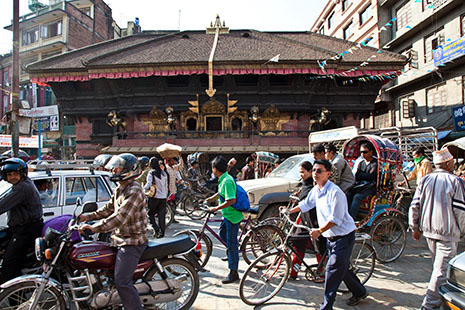
I should come back here, after the trekking, when there is less traffic.
Most of the Nepalese people who will travel with us tomorrow are present and we go through the route with them. Karma and Janbu are familiar with the whole area. It turns out that there is no need to go via Jiri, because we can easily go directly to Shivalaya and overnight there or else in a neighbouring village. However, they do question the wisdom of going via Goli Gompa. Also during my first visit to Duble, in 2001, Kame considered that particular route too steep for me. (He does not like to see me tired). Depending on my condition (and enthusiasm) at the time we’ll review our options. I have had another look at the map. After crossing the Likhu Khola there is a climb of about 1500 m to Goli Gompa. However, there is a village about halfway, where we may perhaps be able to break our journey. We’ll consider the matter when we get there. An ascent of 1500 m is just doable in one day, but I wouldn’t like to make it any more, particularly, since the climb starts after a considerable descent to the river.
I talk Kame into adding an extra, small gas tank to our stores for powering the light in the kitchen tent. I have little faith in the battery powered torches and how long my Solar Tuki will keep going is anybody’s guess. Anyway, I prefer to use that for my own needs.
Back in Thamel, I first go to the bookshop with my complaint. There is another person at the counter who is not at all impressed with my story. However, he is prepared to give me a 100 rupee discount on the correct title in exchange for the wrong one. It’s my turn to be unimpressed and I decide to buy the new book for the full price with the result that Furi and Doma will have 2 books to read.
Kame tells me that Furi complained about the food he gets at KEBS. It’s not enough apparently. Anyway, Furi wants to live at home again. The associated extra costs, bus fares, will amount to no more than 16 rupees a day. I tell Kame that we can only agree to this new regime if it doesn’t lead to Furi putting less effort into his homework. Failure at his end-of-year exams will definitely bring his being sponsored to an end as well.
Kame informs me that Kusang wondered whether we might be able to sponsor one of his children. His wife is expecting and he knows his expenses will increase. I have to tell Kame, that even if we wanted to, we are in no position to take on this extra responsibility. I explain the financial state of the Milijuli Foundation to him. At the end of this year there will at best be just enough left over to fund 2 solar units and 2 stoves.
Back in my hotel room I sort out my belongings and parcel up those items I won’t require during the trip. It amounts to only about 2 kg. I take the parcel to the Multi Adventure Hotel for safekeeping till after the trek. My GPS comes in handy because I take a different route to the hotel. I first walk in the direction of the old location, but at the road junction I go straight ahead and a little later I turn right. After a few hundred meters I turn left for a very short distance to reach my destination. I complete the full circle on my return to the Tibet Guest House by turning left at the hotel towards Kaldhara Marg on the road that eventually, after some 500 m gets me to Chhetrapati.
When I get back to the Tibet Guest House I’m in for another round of compulsory training if I want to get to my room near the roof terrace. "Load shedding" is in force which means there is no electricity and thus no lift. I’ll go to the restaurant tonight just to have a beer and write my diary. I’m not hungry.
Friday, 20-11-2009.
Back in Kathmandu
Saturday, 21-11-2009.
Kathmandu
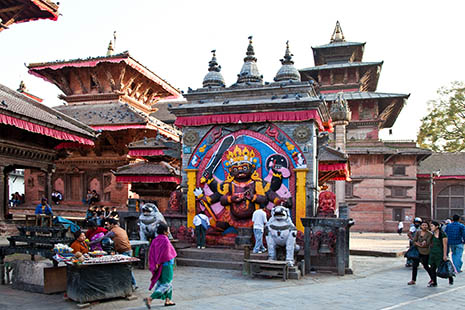
Durbar Square - Kala (black) Bhairab.
The new ING-card, with chip, would not work in the ATM of the Standard Chartered Bank, but worked fine at the Nabil Bank ATM.
Sunday, 22-11-2009.
Kathmandu
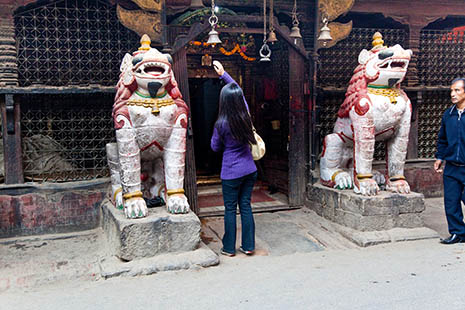
Nara Devi Temple.
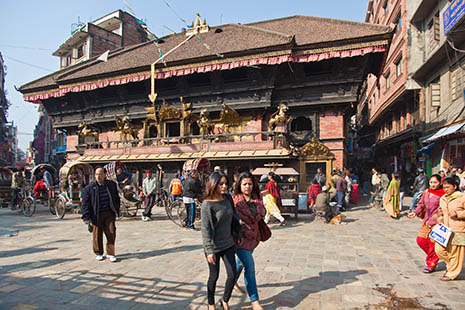
Akash Bhairab Temple. Do you remember the crowded picture, which I took at October 23rd?
Kame has come to the hotel and together we go to the bank where the exchange usually is about 1 rupee higher than at the small offices in the city.
Afterwards, we buy a Casio Electronic Keyboard (CTK-230) for the school in Duble and then we go to Thamel for a pizza. During the lunch I hand Kame the outstanding moneys. That concludes the business affairs of the first 30 days.
We return to the hotel for an appointment with Pradeep Tamang. We repair to the roof terrace for a discussion of Milijuli business matters. That doesn’t take very long and we then switch our attention to the feasibility of building a pico-hydropower station in Duble. Even though the possibilities seem rather limited, they are keen to pursue this matter further. It’s my opinion that we first need to obtain some reasonably accurate measurements as well as data concerning actual material costs and availability. Also, we will have to look at whether and how the electricity generated during daylight hours may be utilised.
According to Pradeep we should be able to get virtually all the required information at the office of the ESAP. We decide to visit that office the next day after which the meeting breaks up.
My laundry has been returned. Although I won’t need my sleeping bag for a while, I do subject it to an inspection which produces a surprise. The zip has partly melted and the bag has become unusable. I lodge a complaint and ask for a new zip to be fitted.
Monday, 23-11-2009.
Kathmandu
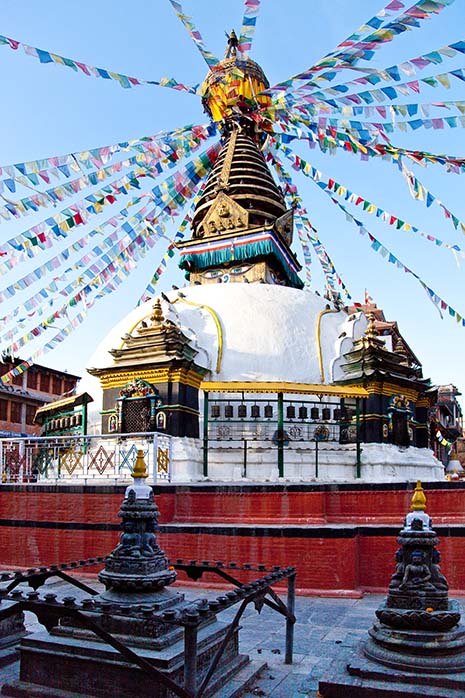
Kathesimbhu stupa.
As it turned out it was a waste of time for me. The discussion was all about possible subsidies whereas I had been told that they would be able to provide useful information about the availability and costs for the materials required to build a pico-hydropowerstation.
For Pradeep and Kame the subsidy is perhaps the most important consideration because it can go as high as some 40% of the total investment. As might be expected, ESAP only deals with ESAP-approved contractors, who must first make a study of the project and report the results. Only after approval has been received, the contractors can commence the actual project. Pradeep is given a list of potential contractors with their contact details. I ask him to write to a few contractors on this list to obtain quotes for doing a survey and he promises to do so. Depending on the costs, there may be some assistance from Stichting Milijuli. However, the contractor must provide adequate details about the survey to be carried out for the quote to be considered (perhaps it would be best to ask for a copy of a past survey).
On our way back, walking through Thamel, Kame somehow manages to steer us past one shop with solar panels and batteries after another. He no doubt recalls my proposing to donate a standard solar tuki to the school in Duble, and to use the battery of that unit, via a transformer, to power the keyboard. It almost seems as if he is looking for a cheaper solution or perhaps he begrudges Hem Bahadur, the school master, the LED-light that would come with the tuki.
After my two Nepalese companions have left for home, I walk to Photo Snapper in New Road to check on their price for the new Canon Macro lens. Via a check on the internet yesterday, I already know the Kamera Express price. The price at Snapper is only 70 Euro lower. For that amount I don’t want to take the risks so I limit my purchases to a few alkaline batteries. On the way back to the hotel I take some pictures at the Kathesimbhu stupa.
Tuesday, 24-11-2009.
Kathmandu.
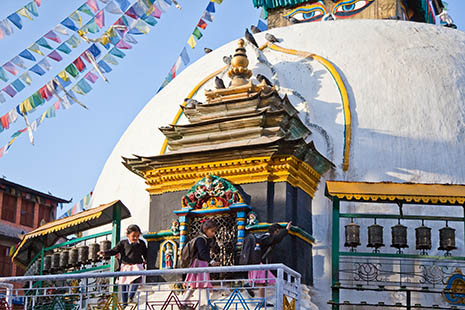
Kathesimbhu stupa.
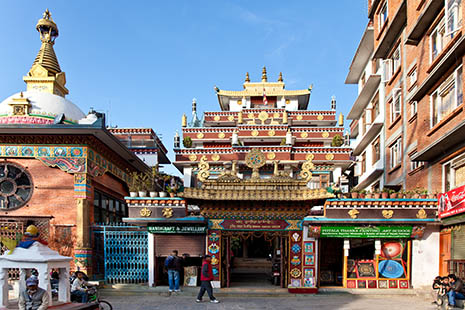
A corner of Sighal Chowk, where the Kathesimbhu stupa is situated.
Kame remains ardently in favour of separate components rather than a standard solar tuki. I say I’ll go along with that as long as his proposal is no dearer than the tuki and provides at least equal utility. He then takes me to a shop where, after what seems an almost endless haggle over a few rupees discount, we lay our hands on an equivalent panel with load controller and lead battery. The battery has a slightly larger capacity than the one in the tuki. The salesman has quite a job to get the whole system operational. Rather amateurish at that. In fact, he starts by soldering a diode which is supposed to prevent the battery from discharging through the panel. And while the diode is probably put in the wrong way round, it is actually quite superfluous because the load controller already contains the necessary safety device.
In another shop I buy myself a 5 Watt CFL for Rs. 180, as well as a 10 m electricity cable for connecting the battery via the load controller to the solar panel and to connect the keyboard to the battery.
By that stage it’s high time for our lunch for which we go to the sandwich shop in Thamel at the three-way intersection underneath the Carlsberg advertisement. We then take all our purchases back to my room in the hotel where we try out the keyboard power supply. I had also planned to visit the museum in the former royal palace but when we take a rickshaw there we discover that it’s closed on Tuesdays and Wednesdays.
Kame then goes home while I stroll back to my hotel. En route I manage to buy a multi-tool to replace the Leatherman which I had to leave behind in Bahrein. I also buy a fleece jacket.
Wednesday, 25-11-2009.
Kathmandu.
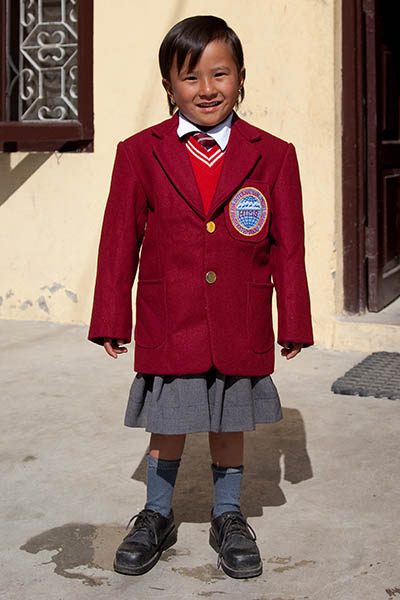
Yangyi in her school dress.
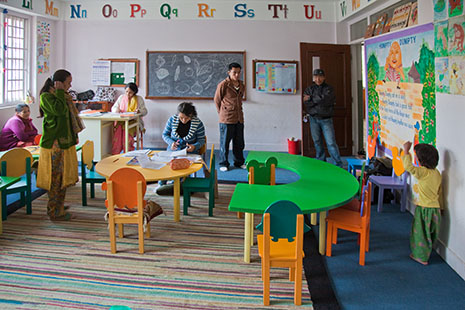
Yangyi shows her classroom at HIMS.
First we drink tea and I take a few pictures of Yangyi in her school uniform. Naina, who has just returned from Pokhara and is staying with Kame until he gets his pay from Multi Adventure tomorrow, joins us in the visit to the hospital.
For more details I refer to the special page,
Aid to Domini Sherpa,
that I made for Stichting Milijuli.
Back at Kame’s I have Daal Bhaat for lunch and spend some time tinkering with the PC to see whether I can get the MP3 player to work. I discover that Kame uses alkali batteries for the LED lights I gave him because he doesn’t know how to use the charger that came with the NiMH batteries. Fortunately, the LED lights have survived this mistreatment but I still impress upon him the need to employ the correct NiMH- battery kits and I explain to him how to use the (12-V) charger.
After lunch, Yangyi gives us a guided tour of HIMS. She does that enthusiastically and cheerfully.
Afterwards I pay a visit to KEBS which is just about in the backyard of the Hyatt Hotel. It looks far less prosperous there, but they are constructing a new building. We can only have a look from the outside because lessons are in progress and we are not allowed to interrupt them.
On my way back to the hotel I call in at the former royal palace to check on the opening times of the museum there, while Kame goes to his own home.
The museum is open on Tuesdays and Wednesdays except public holidays. Opening times are from 11am to 2pm and the entry fee will set me back Rs. 500.
I also visit Multi to find out whether Tulsi Magar is again working at Green Mansions in Chitwan this year. Such is the case. I decide to hire the Multi taxi also for the return trip from Chitwan to Kathmandu and pay for the whole package as well as for my stay at the hotel.
I walk to the tailor’s at about 5 and have to wait for a little while before the pants are ready. I also purchase a grey fleece jacket for Rs. 1200.
Thursday, 26-11-2009.
Kathmandu.
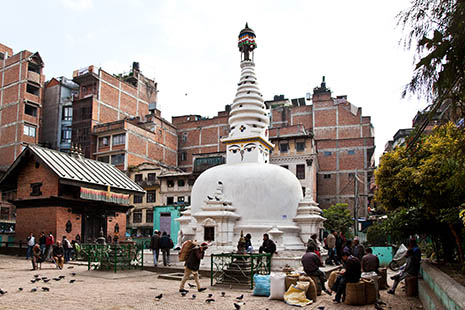
Mahabaudha Stupa.
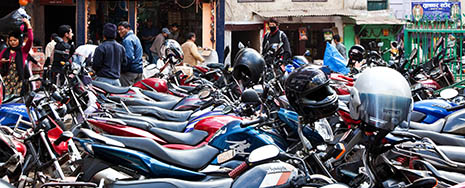
Motorbikes are popular in Kathmandu.
The first part of the exhibition looks rather old fashioned and comprises presents from visiting heads of state and other potentates. We are also shown through the rooms where these guests were received including their bedrooms. The king’s office too is rather old fashioned and contains a case with stereo equipment but no PC. Things become rather more grandiose when we reach the Gorkha hall, where performances took place.
The building that was the site where the murders took place has been demolished except for a few low walls that show where the rooms used to be. The place has been converted into a small park with an ornamental lake.
The remaining building is open for inspection and is in a very poor state of repair, not at all worthy of a palace. For instance, the anti-slip strips on the staircases are caked with dirt. I had expected rather more pomp and circumstance, but it looked more like a castle dating back to the Middle Ages.
I return to the hotel to collect my camera which I’d left behind because cameras are not allowed in the museum. I then go for a walk in Kathmandu to photograph some of the less popular attractions.
Saturday, 5-12-2009.
Back in Kathmandu from Chitwan
Our first stop in Kathmandu is at Kame’s place. After some persistent questioning I’m told how things went during Domini’s visit to the hospital. They have done some laboratory tests and taken an x-ray picture. There is an appointment for 11am on Monday to get the results and be told what treatment might be possible.The Maoists have called a Banda, strike, for tomorrow which means that the planned excursion to Pharping has to be moved to Tuesday. Unfortunately, that also means that there will be no time for an afternoon meeting with Jocelyn in the Garden of Dreams. However, it does mean that tomorrow will be a good day for photographing monuments in the city without being bothered by the normal traffic of cars and bikes. The last few days in Kathmandu I’m staying once more at the Tibet Guest House, because that reservation was made even before I left The Netherlands.
Sunday, 6-12-2009.
Kathmandu.
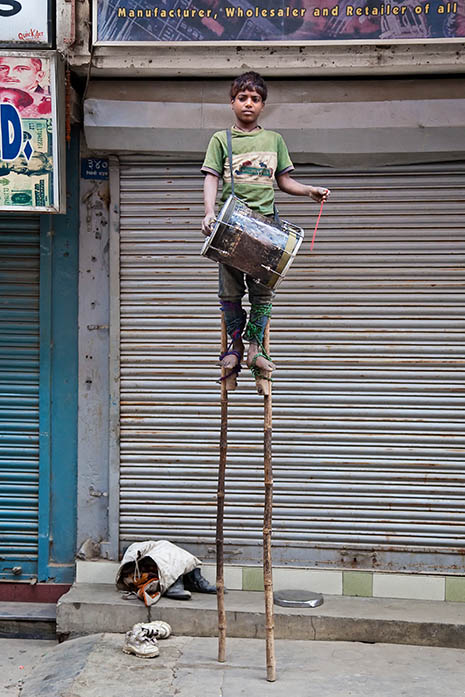
Street artist performing in Thamel.
This was the first time I saw this kind of street artist at work. He was successful because his mate managed to collect some money.
The street artists belong to a low Hindu caste. That may also explain why this particular young artist hardly put up a fight when, after his performance, another boy demanded a share of the proceeds. And even after he handed over some of the money it still came to a fight. A policeman managed to separate the combatants very quickly however.
Monday, 7-12-2009.
Kathmandu.

Baudhanath stupa, as seen from the roof terrace of the Valley Hotel.
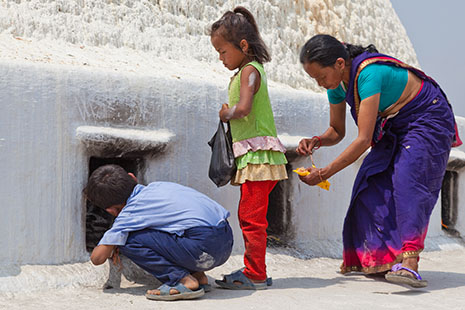
Oblations at the Baudhanath stupa.
We take a taxi to the hospital where Domini and her sister Pemba are waiting for us.
Here I refer again to the special page
Aid for Domini Sherpa,
which I made for Stichting Milijuli.
After lunch I first take a few pictures and then go to the Baudhanath stupa with Kame. I propose to pay a visit to a hotel owned by a Dutch woman who is married to a Nepalese man. By sheer coincidence, Kame had already planned to go there because the woman’s husband, Lobsang Sherpa, has borrowed a mobile phone from him.
The hotel is called The Valley Guesthouse and the woman’s name is Martine Kok. Their trekking company Sherpaland is based at the same premises. The rooms at this hotel are very large.
We go to the roof terrace to drink a cola and are soon joined there by Lobsang.
We complete the kora and I take a taxi back to my hotel. Kame returns to his home.
Tuesday, 8-12-2009.
Visit to Pharping.
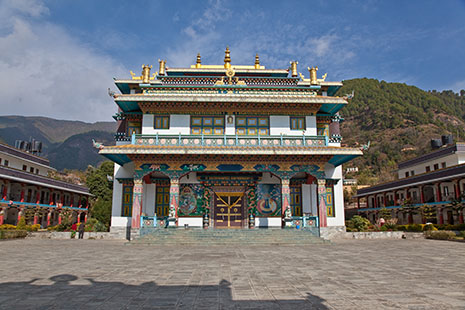
The Rigon Tashi Choeling monastery in Pharping.
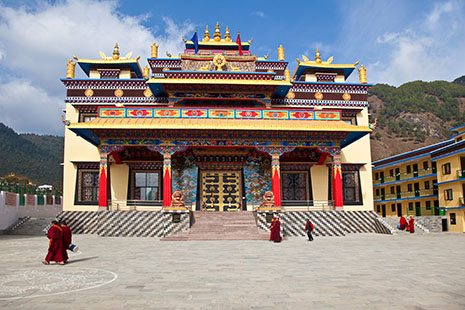
The Samye Memorial Monastery in Pharping.
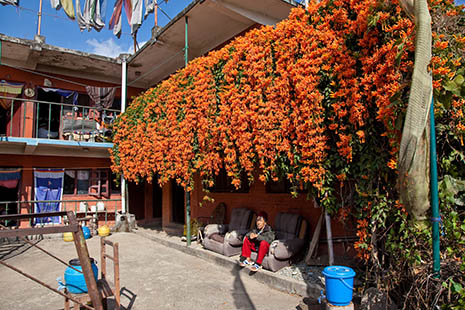
Flowering Columnea, at home an indoor plant, in the courtyard of the Auspicious Pinnacle Dharma Center of Dzongsar in Pharping.
A few kilometres before you reach Pharping is the Samye Rinpoche monastery that has been opened for just a few years. We want to pay it a visit but arrive just too late. Visiting hours are from 8 to 10 and we get there at 10:10. No exceptions are allowed and we are sent on our way. According to our guide they also made it clear that they are not all that keen on visits from tourists.
We then call in at the Reku Tashi Choeling Monastery, where novices are trained, and subsequently at the nearby nunnery which was consecrated only last month and is very beautiful indeed. Its name is the Samye Memorial Monastery.
After that we visit another three places of which I really only needed the names confirmed, because they are some of the most important ones situated close to the cave where Padmasambhava meditated for a week during his journey to Tibet.
Finally, we go to the Sekh Narayan temple. This is a sacred place for Hindus and Buddhists alike. The left is Hindu the right Buddhist.
Then it is time for us to rejoin the traffic jam towards Kathmandu. Traffic on the ring road hardly moves at all during peak hour and crossing this road is also very time-consuming. It takes us a long time to get to the Multi Adventure office. But we do hear some good news along the way on the radio. The Banda (strike) announced for tomorrow has been called off.
At Multi I settle my account, Rs. 6,000 and we drink a cup of tea. Kame works me to the Tibet Guest House, where we say our goodbyes. I give him my tripod for safekeeping till my next visit because I won’t need it anymore for now.
I select the pictures I want to keep and incorporate them on the laptop into my IMatch photodatabase together with their IPTC-data. Before I go to dinner, I start a back-up of the RAW files in which the IPTC-data have been incorporated.
Wednesday, 9-12-2009.
Departure for home.
It was Pradeep’s intention for us to visit Kathmandu Metal Industries, the firm we visited last year. However, this has to be cancelled because there is no relevant staff member available at the premises. Instead Pradeep and Kame hold a number of telephone conversations concerning the pico-hydropower plant. The upshot is that they have two places where they can go for a chat to obtain more information.
One of the firms on the ESAP shortlist mentions an indicative survey cost of Rs. 6,000 per day, excluding the costs for transportation of equipment but including travel and accommodation costs. Pradeep promises to send me the outcomes of all the conversations in due course.
He also mentions that Nijmegen Sherpaland has committed itself to sponsoring drinking water projects and the building of toilets until the year 2015.
When I ask Kame whether he could ask the doctor whether it wouldn’t be advisable for Domini’s kin and other people in close contact with her to be checked for TB, Pradeep tells us that Domini’s grandfather had also suffered from TB.
Kame and Pradeep leave together but Kame is back a little later to give me a bag of peanuts and 3 packets of tea. He too knows that I can’t resist peanuts. One of the packets of tea is for Otto, one is for “Bart’s mother” and the third one is for me.
We get to the airport well before the check in time of 13:00.
Perhaps because I get there so early, my baggage is checked rather more carefully than usual.
I don’t know how it could have happened but my check-in baggage alone weighs 23.5 Kg. I’m then asked to but my carry-on baggage on the scales as well and that of course is my undoing. It amounts to 18.4 kg while my ticket allows for a maximum of 7. In practice they are prepared to allow up to 12 kg.
According to the official these limits are solely due to safety concerns. He produced a box which he thought might be used to send the photobackpack as check-in baggage. Fortunately it wouldn’t fit.
After some further discussions and the transfer of items from the photobackpack to the check-in baggage, which they allowed to go up to 27 kg, we at last managed to have everything checked in even without any extra costs.
This reorganization does, however, means that I’m carrying not only my photobackpack but also a separate camera bag and a jacket. Never mind, that can be solved once I’m onboard by shoving the camera complete with its bag into the photobackpack.
In Bahrain there is the long stopover from 19:00 till 01:50. I must check whether Gulf Air still has a flight, perhaps on another day of the week, with a transfer time of only 2 hours and which departs from Kathmandu a bit later.